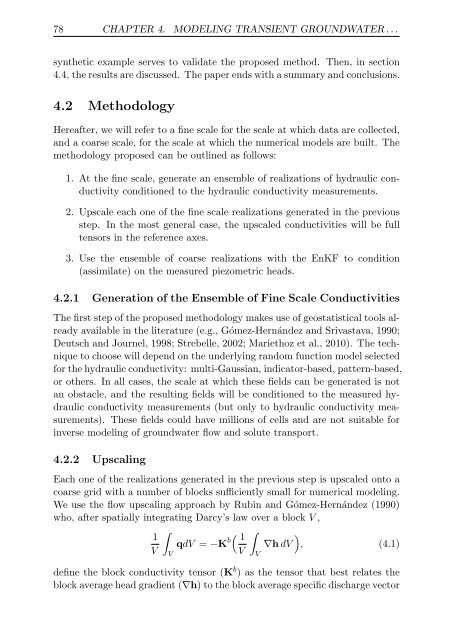Upscaling and Inverse Modeling of Groundwater Flow and Mass ...
Upscaling and Inverse Modeling of Groundwater Flow and Mass ...
Upscaling and Inverse Modeling of Groundwater Flow and Mass ...
You also want an ePaper? Increase the reach of your titles
YUMPU automatically turns print PDFs into web optimized ePapers that Google loves.
78 CHAPTER 4. MODELING TRANSIENT GROUNDWATER . . .<br />
synthetic example serves to validate the proposed method. Then, in section<br />
4.4, the results are discussed. The paper ends with a summary <strong>and</strong> conclusions.<br />
4.2 Methodology<br />
Hereafter, we will refer to a fine scale for the scale at which data are collected,<br />
<strong>and</strong> a coarse scale, for the scale at which the numerical models are built. The<br />
methodology proposed can be outlined as follows:<br />
1. At the fine scale, generate an ensemble <strong>of</strong> realizations <strong>of</strong> hydraulic conductivity<br />
conditioned to the hydraulic conductivity measurements.<br />
2. Upscale each one <strong>of</strong> the fine scale realizations generated in the previous<br />
step. In the most general case, the upscaled conductivities will be full<br />
tensors in the reference axes.<br />
3. Use the ensemble <strong>of</strong> coarse realizations with the EnKF to condition<br />
(assimilate) on the measured piezometric heads.<br />
4.2.1 Generation <strong>of</strong> the Ensemble <strong>of</strong> Fine Scale Conductivities<br />
The first step <strong>of</strong> the proposed methodology makes use <strong>of</strong> geostatistical tools already<br />
available in the literature (e.g., Gómez-Hernández <strong>and</strong> Srivastava, 1990;<br />
Deutsch <strong>and</strong> Journel, 1998; Strebelle, 2002; Mariethoz et al., 2010). The technique<br />
to choose will depend on the underlying r<strong>and</strong>om function model selected<br />
for the hydraulic conductivity: multi-Gaussian, indicator-based, pattern-based,<br />
or others. In all cases, the scale at which these fields can be generated is not<br />
an obstacle, <strong>and</strong> the resulting fields will be conditioned to the measured hydraulic<br />
conductivity measurements (but only to hydraulic conductivity measurements).<br />
These fields could have millions <strong>of</strong> cells <strong>and</strong> are not suitable for<br />
inverse modeling <strong>of</strong> groundwater flow <strong>and</strong> solute transport.<br />
4.2.2 <strong>Upscaling</strong><br />
Each one <strong>of</strong> the realizations generated in the previous step is upscaled onto a<br />
coarse grid with a number <strong>of</strong> blocks sufficiently small for numerical modeling.<br />
We use the flow upscaling approach by Rubin <strong>and</strong> Gómez-Hernández (1990)<br />
who, after spatially integrating Darcy’s law over a block V ,<br />
1<br />
V<br />
∫<br />
V<br />
qdV = −K b( 1<br />
V<br />
∫<br />
V<br />
∇h dV<br />
)<br />
, (4.1)<br />
define the block conductivity tensor (K b ) as the tensor that best relates the<br />
block average head gradient (∇h) to the block average specific discharge vector


